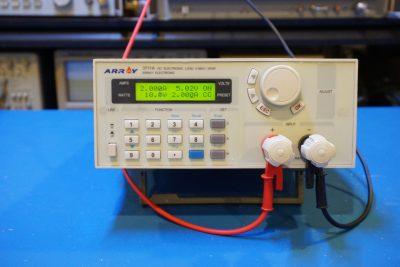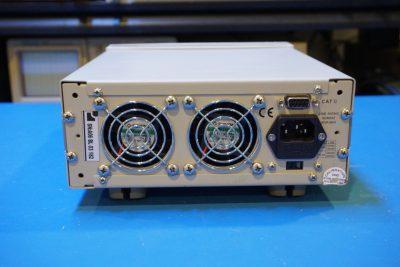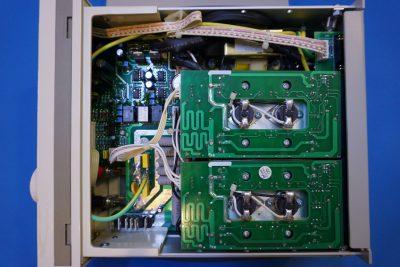Summary of Teardown of an Array 3711A 300W DC Electronic Load
The article details the teardown of an Array 3711A DC electronic load purchased on eBay. This compact unit can dissipate 300W, handling up to 30A and 300V, and operates in constant current, power, or resistance modes. The efficient forced-air cooling uses four fans to manage heat in a tight layout. Internal components include power boards mounted directly on heatsinks, a microcontroller board behind the front panel, OP07 ultra-low offset OpAmps, three relays controlling sensing and load switching, paralleled IRF3205 MOSFETs, and wire-wound power resistors. Disassembly is challenging due to compact design and tight component placement.
Parts used in the Array 3711A 300W DC Electronic Load:
- Four cooling fans (two intake, two exhaust)
- Power module boards mounted on heatsinks
- Microcontroller board
- Front panel digital board
- Analog bottom board
- OP07 ultra-low offset voltage operational amplifiers
- Three relays (two for input voltage and current sensing, one for load switching)
- Six paralleled IRF3205 MOSFETs
- Wire-wound power resistors
- Front panel binding posts
I have made many electronic loads in the past. For instance this simple harddrive cooler housed small dummy load, this more sophisticated constant current/constant programmable load and this heavy-duty electronic load that is capable of sinking over 1kW under peak load. In this blog post though, I am going to take a look inside an Array 3711A DC electronic load I recently purchased on eBay. You can find a video of this teardown towards the end of the post.
The Arrary 3711A can sink 300W with a maximum load current of 30A and maximum load voltage of 300V. It can be used in constant current, constant power or constant resistance mode and can be controlled remotely via an RS232 interface.
The entire unit is actually quite compact given the amount of power it is capable of dissipating. This can be largely attributed to the efficient forced-air cooling system it uses. There are four fans all together. Two are sitting at the bottom of the chassis that sucks in air. The air then flows through the heatsinks and the hot air gets blown out from the back via another two fans.
To achieve this compact design, some sacrifices need to be made. This becomes apparent after opening up the top cover. As you can see in the picture below, the power module boards are mounted directly on the heatsinks and the microcontroller board is tucked away behind the front panel. And to access any components located on either the front panel digital board or the analog board located at the bottom of the case you have no choice but to partially dissemble the unit.
And this is exactly what I did. Taking out the front panel is not quite trivial as it turned out. The front panel binding posts are screwed onto the connectors that are soldered onto the bottom board. Getting to these nuts are not easy given the tight clearance. With quite a bit of effort, I was able to eventually take out the bottom main board for a closer look.
In the picture to the left below, you can see most of the components on the board. The main OpAmps used in the 3711A are OP07 ultra-low offset voltage OpAmps. There are three relays in the unit, two appears to be controlling the input voltage and current sensing and one controls the six paralleled IRF3205which switch the load on and off. Quite a few of the wire-wound power resistors can also be seen.
Read more: Teardown of an Array 3711A 300W DC Electronic Load



